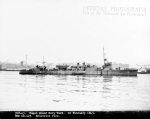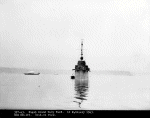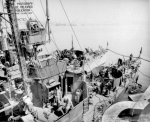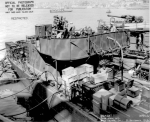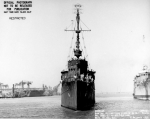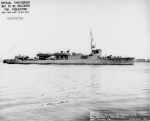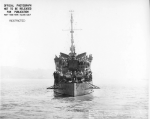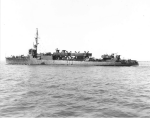 |
55k |
Winfield Scott Schley was born in Frederick City, Maryland on 9 October 1839. He was appointed to the United States Naval Academy from
Maryland, in 1856, and graduated in 1860. He married Annie R. Franklin on 10 September 1863. Schley was promoted to midshipman on 15 June 1860, Master, 25 July 1866,
Commander, 19 June 1874, Captain, 31 March 1888, Commodore, 6 February 1898 and Rear Admiral, 3 March 1899. He served in USS Niagara (1860-61), USS Keystone State (1861),
USS Potomac storeship, at Ship Island (1861-62), USS Winona, West Gulf Blockading Squadron (1862-63). He participated in engagement with a battery near Port Hudson on 14
December 1862. These engagements led to the capture of Port Hudson (March-July 1863). He served in USS Wateree of the Pacific Squadron (1864-66). He accomplished the
following: taught at the US Naval Academy (1866-69) and (1872-76); served in the gunboat USS Benecia of the Asiatic Squadron (1869-72), taking part in the landing and
capture of Korean forts at the Han River in June 1871, under Commander John Rodgers; commanded USS Essex, in the Brazil Squadron (1876-79); a lighthouse inspector, 2nd
district in Boston (1880-83); In 1884 he commanded the expedition to rescue the Arctic party under Army Lieutenant Adolphus Washington Greely, in the flagship Bear, along
with vessels Thetis and Alert. He rescued Lieutenant Greely and 6 survivors at Cape Sabine, Greenland, who had been out of touch since 1881. For this rescue effort, he
was awarded a gold watch and a vote of thanks of the Maryland legislature and a gold medal from the Massachusetts Humane Society; later served as the Chief of the Bureau
of Equipment and Repair (1884-89); commanded the cruiser USS Baltimore, in the South Pacific (1889-92), on 16 October 1891, a liberty party was attacked by a mob in
Valparaiso, Chile, and two sailors were killed. He maintained a firm but tactful presence in the harbor until relieved by USS Yorktown, commanded by Robley D. Evans, in
November; was a Lighthouse Inspector again (1892-95); commanded the New York (1895-97), and then was Chairman of Lighthouse Board (1897-98). During the Spanish-American War, he commanded the Flying Squadron, based at Hampton Roads in April 1898. The squadron's mission was to be ready to meet any Spanish force in Atlantic or Caribbean. In May, the Spanish fleet under Admiral Cervera, having been detected making for Cuba, he was ordered to join his squadron to the main fleet under Admiral William Thomas Sampson, to whom he was technically superior in rank. Sampson ordered him on May 18 to blockade southern Cuban ports, principally Santiago and Cienfuegos, but before he organized his forces Cervera slipped into Santiago on May 19. He took up a position outside Santiago on May 26, but a few hours later left, intending to return to the main Navy base at Key West, Florida, to refuel. He managed a refueling at sea, however, and resumed his position outside of Santiago on May 28, being joined by Sampson on June 1. On the morning of July 3, while Sampson was on his way to conference ashore, Cervera's fleet attempted to run blockade. Though in immediate command, he issued no special orders, and the squadron executed Sampson's standing orders to run down Spanish fleet. The principal exception was the cruiser Brooklyn, Schley's flagship, which unaccountably turned in direction opposite that of the rest of squadron, causing considerable confusion and narrowly escaping collision with the Texas. The Brooklyn was nonetheless conspicuous in battle, particularly against Cervera's flagship Maria Teresa, which was run ashore. Schley, the senior office present, was eager to accept credit for victory, while newspapers and the public, to whom he was already a familiar and heroic figure, were eager to give it, ignoring the somewhat aloof Sampson. A controversy quickly developed, delaying promotions of both men until March 1899, when both were made Rear Admiral. As a rear admiral he was promoted to Commander-in-Chief, South Atlantic Squadron (1899-1901). By that time the Sampson-Schley controversy had become even more heated, at least on the parts of their respective partisans, and in July 1901 he requested and was granted court of inquiry. In December a majority of the court, presided over by George Dewey, reported against Schley, particularly in matters of tardy movements, the outward turn of the Brooklyn, and other matters. Dewey himself, however, submitted a minority report in his favor. On appeal, Theodore Roosevelt approved majority report in January 1902. He retired from the US Navy on 9 October 1901. He was presented with a gold sword by the people of Pennsylvania, a silver sword by Royal Arcanum, a gold and jeweled medal with the thanks of Maryland legislature, silver service, for services at the battle of Santiago. He was the author of The Rescue of Greely in 1885 and Forty-5 Years Under the Flag in 1904. He died on, 2 October 1909, 7 days before his 70th birthday, in New York City. A gate at the Arlington National Cemetery was named in his honor, where he is buried.
Digital ID: cph 3c21092 Source: Library of Congress Prints and Photographs Division Washington, D.C.
| Bill Gonyo |


